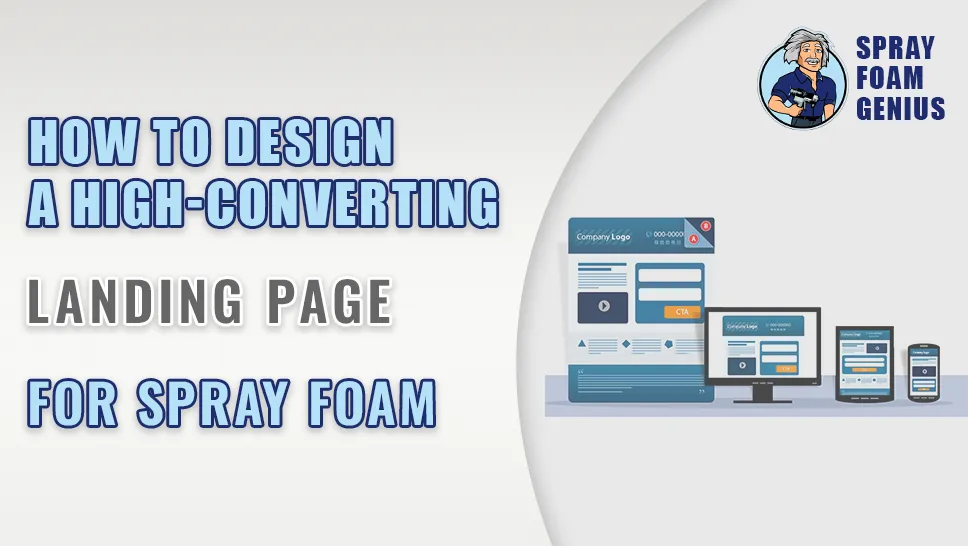
Creating an effective landing page is crucial for spray foam insulation contractors looking to convert online visitors into potential clients. At Spray Foam Genius Marketing, we specialize in optimizing online strategies for spray foam insulation businesses. In this detailed guide, we’ll delve into the essential elements of designing a high-converting landing page specifically for spray foam insulation services. By implementing these strategies, you’ll enhance your online presence, engage your audience, and boost your lead generation efforts.
Why a High-Converting Landing Page is Essential
The Significance of a Well-Crafted Landing Page
A landing page is where your potential clients first interact with your online presence. It’s a critical touchpoint that can determine whether a visitor becomes a lead or leaves without engaging. For spray foam insulation contractors, a high-converting landing page is not just an option but a necessity. It needs to effectively communicate your value proposition, capture interest, and motivate action.
An optimized landing page enhances user experience, increases the likelihood of conversions, and ultimately contributes to business growth. By focusing on creating a landing page that resonates with your target audience, you set the foundation for successful digital marketing efforts.
Key Elements of a High-Converting Spray Foam Landing Page
1. Craft a Clear and Compelling Headline
Your headline is the first element visitors encounter, and it must immediately grab their attention. A clear, compelling headline should communicate your main value proposition and include relevant keywords, such as “spray foam insulation.” An effective headline might be: “Enhance Your Home’s Efficiency with Our Expert Spray Foam Insulation Services.” This headline not only highlights the benefit of your services but also incorporates essential keywords for SEO.
Why It Matters: The headline sets the tone for the rest of the landing page. It should be straightforward, address your audience’s pain points, and entice them to learn more about your services.
2. Utilize Engaging and High-Quality Visuals
Visual elements play a significant role in catching the eye and conveying your message. Use high-quality images or videos that showcase your spray foam insulation projects. Before-and-after photos, videos demonstrating your process, or client testimonials can effectively illustrate the benefits of your services.
Why It Matters: Engaging visuals create a more appealing landing page and help build trust with visitors. They provide a visual representation of your work, making your services more tangible and credible.
3. Design a Persuasive Call-to-Action (CTA)
Your CTA is a crucial component of your landing page, guiding visitors toward taking action. It should be prominent, clear, and action-oriented. Effective CTAs for a spray foam insulation landing page might include phrases like “Get Your Free Quote Now” or “Schedule a Free Consultation.”
Why It Matters: A well-designed CTA encourages visitors to take the next step. Place CTAs strategically throughout the page—ideally after key information or compelling content—to increase the likelihood of conversions.
4. Incorporate Trust-Building Elements
Trust is a significant factor in converting visitors into leads. Include elements that build credibility and reassure potential clients of your expertise. This can include client testimonials, case studies, industry certifications, and recognizable badges or awards. Highlighting positive feedback and successful projects reinforces your reliability and competence.
Why It Matters: Trust-building elements help overcome skepticism and foster confidence in your services. They provide social proof and demonstrate that others have had positive experiences with your company.
5. Optimize the Contact Form for User Convenience
The contact form is where visitors provide their details to become leads. Design your form to be user-friendly and straightforward. Request only the essential information—such as name, phone number, and email address—to avoid overwhelming users. Ensure the form is easily accessible and functions well on both desktop and mobile devices.
Why It Matters: A streamlined contact form encourages more submissions by reducing friction and making it easy for potential clients to reach out. A complicated or lengthy form can deter
6. Ensure Mobile Optimization
In today’s mobile-centric world, ensuring that your landing page is optimized for mobile devices is essential. A mobile-friendly design ensures that your page looks and functions well on smartphones and tablets. Test your landing page across various devices and screen sizes to confirm that it offers a seamless user experience.
Why It Matters: Mobile optimization improves user experience, reduces bounce rates, and increases the chances of conversions. A responsive design ensures that your landing page is accessible to all users, regardless of their device.
7. Implement SEO Best Practices
To attract organic traffic and improve visibility, optimize your landing page for search engines. Incorporate primary and secondary keywords naturally throughout the content, including in the headline, subheadings, and body text. Utilize meta descriptions, alt text for images, and internal and external links to enhance SEO.
Why It Matters: SEO optimization helps your landing page rank higher in search engine results, making it more likely that potential clients will find you. Effective SEO practices also improve the overall relevance and authority of your page.
8. Prioritize Fast Loading Times
Page speed is crucial for both user experience and SEO. A slow-loading landing page can lead to high bounce rates and negatively impact conversions. Optimize images, use browser caching, and minimize unnecessary code to enhance loading times. Tools like Google PageSpeed Insights can help identify areas for improvement.
Why It Matters: Faster loading times lead to a better user experience and higher conversion rates. A speedy landing page reduces frustration and keeps visitors engaged, increasing the likelihood of them taking action.
9. Conduct A/B Testing
To continuously improve your landing page’s performance, conduct A/B testing on various elements. Experiment with different headlines, CTAs, images, and form designs to determine which variations produce the best results. Analyze the data from these tests to make informed decisions and optimize your landing page accordingly.
Why It Matters: A/B testing provides valuable insights into what works best for your audience. By testing different elements, you can refine your landing page to achieve higher conversion rates and better overall performance.
10. Utilize Analytics and Tracking Tools
Implement analytics and tracking tools to monitor visitor behavior and measure the effectiveness of your landing page. Tools like Google Analytics and heatmaps can provide insights into how visitors interact with your page, track conversions, and identify areas for improvement.
Why It Matters: Analytics and tracking tools help you understand user behavior and evaluate the success of your landing page. By analyzing this data, you can make data-driven decisions to enhance your page’s performance and drive better results.
Installation Process and Best Practices
1. Preparation
Before applying spray foam insulation, it’s essential to prepare the site adequately. This involves:
- Cleaning the Surface: Ensure that the surfaces to be insulated are clean, dry, and free from dust, dirt, and debris.
- Sealing Gaps: Any large gaps or holes should be sealed before applying spray foam to ensure an even application and prevent leaks.
2. Application
Spray foam insulation is applied using a spray gun that mixes the foam components on-site. The foam expands upon application, filling gaps and creating a seamless barrier.
- Temperature and Humidity: The application process is sensitive to temperature and humidity. Ensure that the conditions are within the recommended range for optimal curing and performance.
- Layering: Apply the foam in layers if necessary to achieve the desired thickness. Allow each layer to cure before applying the next.
3. Curing
After application, the foam needs time to cure and expand fully. This typically takes 24 to 48 hours, depending on environmental conditions.
- Ventilation: Ensure proper ventilation during the curing process to facilitate off-gassing and to ensure a safe working environment.
4. Inspection and Testing
Once the foam has cured, inspect the installation to ensure it meets the desired specifications. Look for any areas that may require touch-ups or additional foam.
- Air Seal Testing: Perform tests to ensure there are no air leaks and that the insulation is performing as expected.
Choosing the Right Contractor

Selecting the right contractor for spray foam insulation is crucial to ensure a high-quality installation. Consider the following when choosing a contractor:
1. Experience and Expertise
Look for contractors with extensive experience in spray foam insulation. They should have a track record of successful projects and a thorough understanding of different insulation requirements.
2. Certifications and Licensing
Ensure that the contractor is properly licensed and certified to apply spray foam insulation. This ensures compliance with industry standards and regulations.
3. References and Reviews
Check references and read reviews from previous clients to gauge the contractor’s reputation and reliability.
4. Detailed Quotes
Request detailed quotes that outline the scope of work, materials to be used, and the total cost. This helps avoid surprises and ensures transparency.
Conclusion
Designing a high-converting spray foam landing page requires a strategic approach that focuses on key elements such as clear headlines, engaging visuals, persuasive CTAs, and trust-building features. By implementing these strategies and optimizing your landing page for both desktop and mobile users, you can effectively capture and convert leads.
At Spray Foam Genius Marketing, we are dedicated to helping spray foam insulation contractors enhance their online presence and achieve their business goals. If you’re ready to take your landing page to the next level, contact us at 877-840-FOAM for USA and 844-741-FOAM for Canada visit our website at sprayfoamgeniusmarketing.com, or email us at [email protected] to get started.
Let us assist you in designing a landing page that not only attracts but also converts potential clients, driving your business growth.
- Social Media Marketing for Spray Foam Businesses: What Works in 2025? - February 6, 2025
- Best SEO Strategies for Spray Foam Insulation Contractors to Rank #1 on Google - February 6, 2025
- What is Spray Foam Insulation? Benefits and Applications - February 5, 2025

